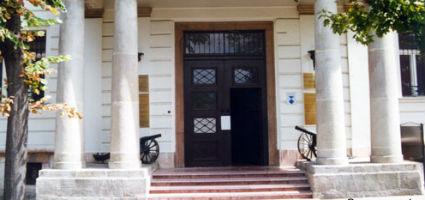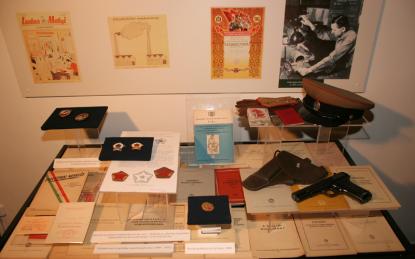2024. April 26. Friday
HM, Museum and Institution of Military History - Budapest
 |
Address: 1014, Budapest Tóth Árpád sétány 40.
Phone number: (1) 325-1600, (1) 325-1601
E-mail: him@militaria.hu
Opening hours: 01.04-31.09.: Tue-Sun 10-18
01.10-31.03.: Tue-Sun 10-16 |
Museum tickets, service costs:
|
Ticket for adults
|
1400 HUF
|
/ capita
|
|
Ticket for students
(6-26 years of age)
|
700 HUF
|
/ capita
|
|
Group ticket for students
|
300 HUF
|
|
|
Ticket for pensioners
(62-70 years of age)
|
700 HUF
|
/ capita
|
|
Ticket for families
(max. 2 adults + 4 children)
|
2500 HUF
|
/ family
|
|
Program ticket
|
700 HUF
|
|
|
Guide
|
700 HUF
|
|
|
Guide
|
8000 HUF
|
/ max. 20 capita
|
|
Guide
|
12000 HUF
|
/ min. 20 capita
|
By the end of the 1940's, power was in the hand of the communist by the Russians overseeing them. Hungary became the vassal of the Soviet Union with all the political, economic and military consequences. The following forty years behind the Iron Curtain was the era of National Socialism, the darkest episode coming in the first part of the 1950's with Mátyás Rákosi as the head of the country. The Hungarian armed forces fit in the dictatorial system as the means of the oppressive powers. The Hungarian People's Army, first in consequence of bilateral agreements, from 1955 in the framework of the Warsaw Treaty, enhanced the power of the 'Peace Camp' as the ally of the Russian Army. Hungary was preparing for the ultimate battle between the two systems, capitalism and socialism, WWIII. The consequence of this was sensible. The development of the army did not fit the capacity inherent in the state which almost eviscerated the country at the beginning of the fifties.

By the fall of 1956 the system was shattered by political, economic and social issues. Demonstrations on 23 October turned into armed fights which continued as a war of independence against the Russian army in the following days. Many of the soldiers and officers in the Hungarian People's Army joined the revolt. Many of them died or were victims of revenge following the fight. Part of the upper deck ratings participated in the fights against the revolts, as well as in the consolidation of the system symbolised by János Kádár. These officers became the most trustworthy leaders of the newly organized People's Army.
The years following the revolution, the 1960's passed with the reorganization of the system, the modernisation of the army. By the middle of the 1960's, the Hungarian People's Army reached the averaged level of the armies of the Warsaw Treaty. Just as the other armies, it played the role of the underdog beside the Russian Army. The Hungarian People's Army participated in only one significant action, the occupation of Czechoslovakia on 1968.
Our exhibition presents the military event of these twenty years by reviewing the Revolution of 1956 and the Hungarian People's Army.
Our main objective was to fit the Revolution of 1956 in the history of the era by thematically grouping the material. We picture 1956 the way that it is not only an island in the history of Hungary but as the result of the dictatorship and the oppression of the 1950's. We wanted to show that in some sense the army was the victim of the dictatorship and that the role of the army in the events of 1956 was determined by the preceding decade.
We are planning to build up a section dealing with the history of the Hungarian People's Army in 1970 - 1980. The life expectancey of the exhibition is 15 years.

By the fall of 1956 the system was shattered by political, economic and social issues. Demonstrations on 23 October turned into armed fights which continued as a war of independence against the Russian army in the following days. Many of the soldiers and officers in the Hungarian People's Army joined the revolt. Many of them died or were victims of revenge following the fight. Part of the upper deck ratings participated in the fights against the revolts, as well as in the consolidation of the system symbolised by János Kádár. These officers became the most trustworthy leaders of the newly organized People's Army.
The years following the revolution, the 1960's passed with the reorganization of the system, the modernisation of the army. By the middle of the 1960's, the Hungarian People's Army reached the averaged level of the armies of the Warsaw Treaty. Just as the other armies, it played the role of the underdog beside the Russian Army. The Hungarian People's Army participated in only one significant action, the occupation of Czechoslovakia on 1968.
Our exhibition presents the military event of these twenty years by reviewing the Revolution of 1956 and the Hungarian People's Army.
Our main objective was to fit the Revolution of 1956 in the history of the era by thematically grouping the material. We picture 1956 the way that it is not only an island in the history of Hungary but as the result of the dictatorship and the oppression of the 1950's. We wanted to show that in some sense the army was the victim of the dictatorship and that the role of the army in the events of 1956 was determined by the preceding decade.
We are planning to build up a section dealing with the history of the Hungarian People's Army in 1970 - 1980. The life expectancey of the exhibition is 15 years.
|
Related activities
|
|
